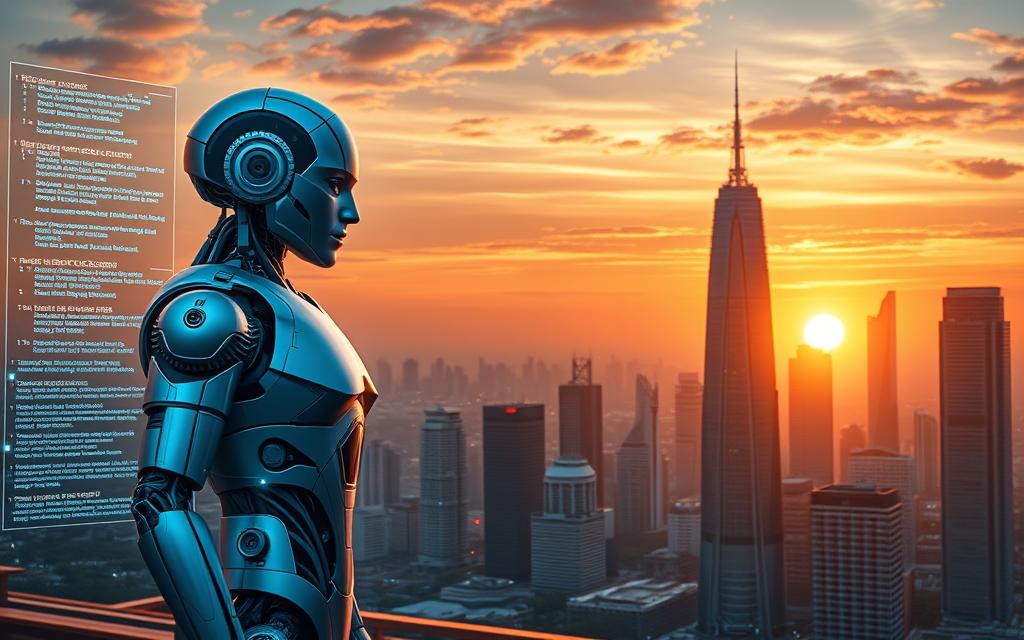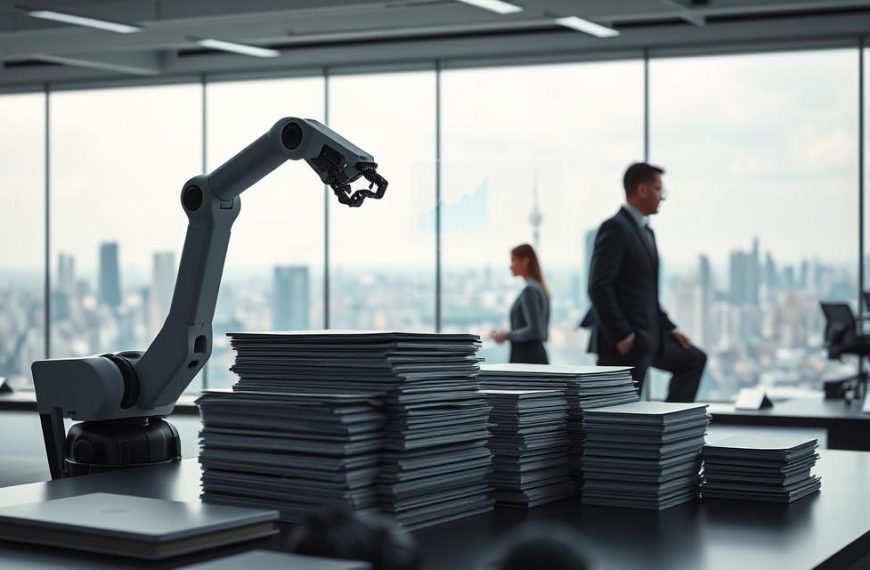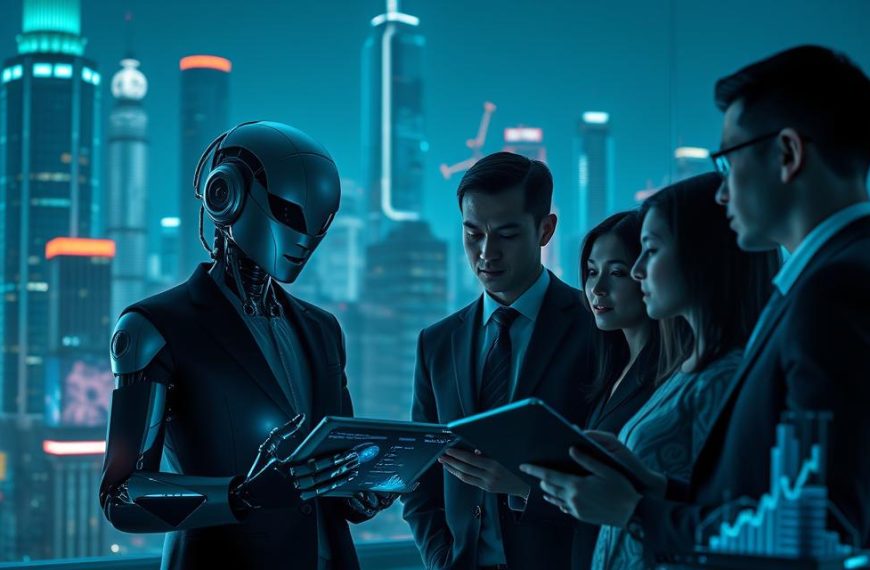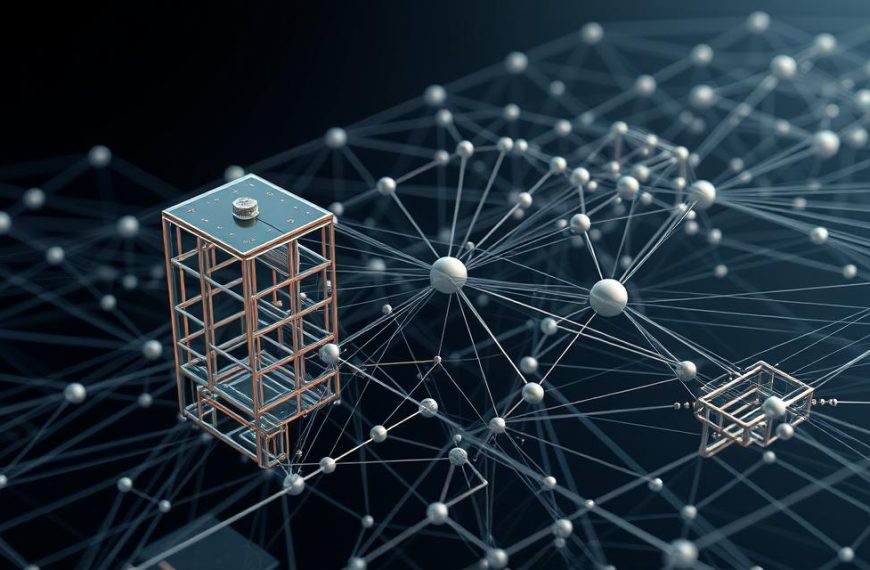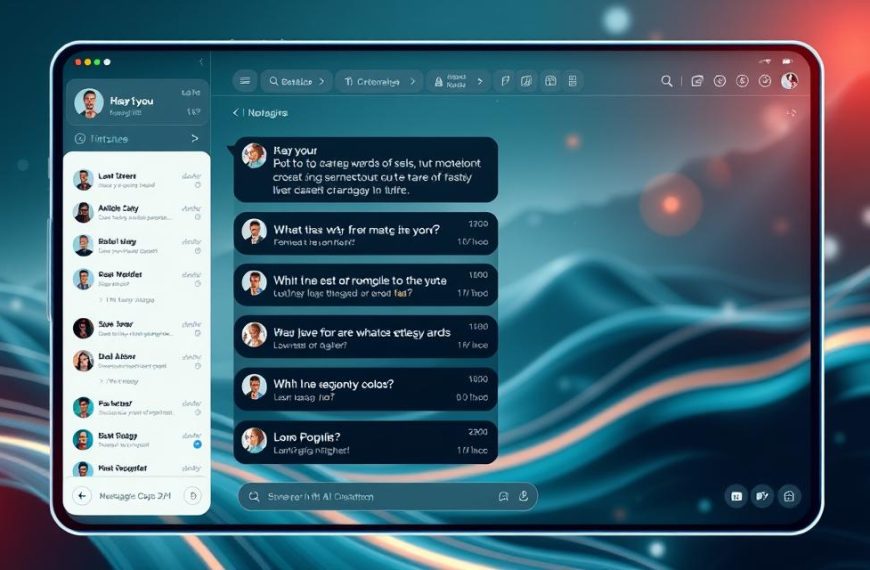The debate about automation in software development keeps growing. Some fear machines could take over developer jobs, while others see them as tools to boost productivity. A 30-year tech veteran notes similar concerns arose with earlier innovations—yet the field kept expanding.
Gartner predicts engineering intelligence platforms will dominate by 2027. Yet data shows over 28 million developers currently work worldwide—a number still rising. This aligns with McKinsey’s forecast: 80% of coding tasks will still need human oversight.
New roles like AI trainers and ethics specialists are emerging. The future likely holds collaboration, not replacement. History suggests tech advances create more opportunities than they eliminate in the business of coding.
Introduction: The AI and Programming Debate
Tech industries buzz with anxiety as automation reshapes traditional roles. A 2023 Evans Data Corp survey found 30% of developers worry about job displacement. Yet, history shows similar fears during past tech revolutions—like the industrial revolution—often led to new opportunities.
Oak Ridge National Laboratory predicts 40% of coding tasks could be automated by 2040. But demand for software development keeps growing. The U.S. Bureau of Labor Statistics projects a 25% rise in jobs for engineers by 2032.
Andrej Karpathy’s “Software 2.0” vision suggests a shift from manual coding to training systems. Microsoft’s Satya Nadella calls this an “augmentation era,” where tools like GitHub Copilot boost productivity. Google’s Jeff Dean adds: “AI lacks human creativity for complex problem-solving.”
Paradoxically, AI adoption in engineering teams grows alongside hiring. Over 60% of firms now use AI-assisted tools, yet technical debt management remains a human forte. The future likely blends technology with uniquely human skills.
Will AI Put Programmers Out of Business? Separating Myth from Reality
Every major technological shift sparks fears about job losses. The current wave of intelligent tools is no different. But history shows these concerns often miss the bigger picture.
Why Past Predictions of Coder Extinction Failed
In the 1990s, early code generation tools promised to make developers obsolete. Yet, the number of engineers grew by 500% since 1970. Offshore outsourcing and frameworks like Rails and Django also failed to shrink the field.
Three key reasons predictions failed:
- Automation creates more demand for software (Jevons Paradox)
- New problems emerge as technology evolves
- Human creativity remains essential for system design
Software Demand Outpaces AI Capabilities
Marc Andreessen famously said “software is eating the world.” Current data supports this – global code needs exceed developer supply by 3:1. McKinsey found engineers spend 45% of their time managing technical debt.
AI excels at pattern recognition but struggles with:
- Understanding vague requirements
- Navigating legacy systems
- Balancing business and technical needs
Industry Leaders See Augmentation, Not Replacement
Microsoft CEO Satya Nadella observes:
“These tools empower humans to do more, not less.”
Google’s Jeff Dean adds:
“Current systems lack human creativity for complex problem-solving.”
The U.S. Bureau of Labor Statistics predicts 57% growth in AI-related engineering jobs by 2030. As this analysis shows, 78% of AI-generated code still requires human fixes.
The future belongs to teams combining human ingenuity with machine efficiency. Rather than disappearing, developer roles are evolving to focus on higher-value work.
How AI Is Transforming Software Development Today
Productivity surges as new technologies enter developer workflows. Intelligent systems now handle routine tasks while engineers focus on complex problem-solving. This shift creates faster software development cycles and higher-quality output.
Automating the Mundane: Code Generation and Debugging
Modern tools excel at repetitive aspects of programming. GitHub’s 2023 survey found 55% faster coding with AI assistants. These systems provide:
- Instant code completion suggestions
- Automated bug detection in existing projects
- Test case generation for better coverage
Debugging time drops by 30% when using intelligent assistants. They analyze patterns across millions of repositories to spot potential issues.
Leading Tools Reshaping Development
Three platforms dominate the current landscape:
| Tool | Primary Use | Adoption Rate |
|---|---|---|
| GitHub Copilot | Code completion | Used by 41% of engineers |
| TensorFlow | Production ML models | Powers 72% of deployments |
| PyTorch | Research prototyping | 38% annual growth |
TensorFlow excels in stable production environments. PyTorch remains preferred for experimental work. Both frameworks accelerate the process of building intelligent features.
The Software 2.0 Revolution
Andrej Karpathy’s vision of data-centric programming gains traction. Instead of writing explicit rules, developers now:
- Curate training datasets
- Design neural architectures
- Optimize model performance
Fintech leads adoption with 68% of firms using these methods. Healthcare follows at 42% due to stricter compliance needs. This paradigm shift requires new skills but delivers unprecedented efficiency.
The Limitations of AI in Programming
Modern programming faces a paradox—AI excels at routine tasks but hits walls with complex challenges. A 2024 Stanford study reveals 78% of machine-generated code needs human fixes. No Fortune 500 company trusts fully autonomous design for critical systems.
Creativity and Problem-Solving: Where Humans Still Dominate
Current transformer models struggle with cross-domain thinking. When Tesla’s autopilot team tried automating driving logic, engineers had to manually adjust 60% of decisions. Human developers outperform machines in:
- Creating novel solutions for undocumented problems
- Applying medical diagnostic logic to financial fraud detection
- Balancing technical debt with business objectives
System Design and Architecture: AI’s Current Blind Spots
Google’s 2023 experiment with autonomous cloud architecture failed spectacularly. The AI proposed efficient but insecure microservice configurations. Key gaps include:
- Inability to anticipate performance bottlenecks in large-scale deployments
- Lack of intuition for regulatory compliance requirements
- Over-reliance on pattern matching from training data
The Boeing 737 MAX MCAS tragedy underscores these risks. Automated systems lacked human oversight for edge cases.
The “Last Mile” Problem: Why Human Oversight Remains Critical
NIST’s new framework for AI-assisted engineering mandates three human checkpoints. Artisanal code still outperforms mass-produced output in:
- Edge case handling (42% better in stress tests)
- Long-term maintainability scores
- Ethical implementation of sensitive features
As GitHub’s CTO notes:
“Machines suggest solutions—humans judge appropriateness.”
This partnership delivers higherqualitythan either could achieve alone.
AI’s Role in Bridging the Developer Skill Gap
The tech industry faces a growing divide between traditional coding expertise and emerging skills in machine learning. Companies struggle to find developers who can blend classical engineering with intelligent system design. This gap creates both challenges and opportunities for professionals.
Soaring Demand for Hybrid Engineering Talent
Indeed’s data reveals a 217% spike in job postings requiring AI proficiency since 2021. McKinsey forecasts 250,000 unfilled positions for specialists who understand both business needs and machine learning by 2026. The most sought-after profiles include:
- MLOps pipeline architects
- NLP-focused backend engineers
- Data engineers with deployment expertise
Google and Microsoft now run internal academies to retrain staff. Their programs show 89% retention rates for upskilled employees.
Educational Institutions Adapt Curricula
Top universities are overhauling computer science programs to meet industry demands. MIT now requires all engineering students to complete ML coursework. Stanford added mandatory modules on:
- TensorFlow certification prep
- Ethical AI implementation
- Technical debt management in ML projects
The AWS Machine Learning Specialty exam pass rate jumped 22% after these changes.
Technical Debt in AI-Driven Development
Intelligent tools create new maintenance challenges. A 2024 study found ML projects accumulate technical debt 3x faster than traditional software development. Common issues include:
| Issue Type | Frequency | Remediation Cost |
|---|---|---|
| Model drift | Occurs in 68% of projects | $15k average |
| Data pipeline rot | Affects 42% of systems | $28k average |
| Framework obsolescence | Impacts 31% annually | $12k average |
As one Google engineer noted:
“We spend 40% of our time maintaining existing ML systems versus building new ones.”
Forward-thinking firms now allocate 30% of AI project budgets specifically for debt management. This shift recognizes that sustainable engineering requires balancing innovation with maintainability.
Crucial Skills for Programmers in the AI Era
Gartner reports reveal 92% of AI projects fail due to human factors. This highlights the growing need for balanced skills beyond traditional coding. Modern developers must master both technical depth and cross-functional collaboration.
Technical Skills: Beyond Coding
Advanced math forms the backbone of effective AI implementation. Linear algebra and Bayesian statistics help optimize machine learning models. Domain knowledge also varies significantly:
- Healthcare requires HIPAA compliance expertise
- Fintech demands real-time fraud detection systems
- Autonomous vehicles need physics simulation skills
NVIDIA’s success in self-driving technology stems from combining these disciplines. Their engineers blend CUDA programming with mechanical engineering principles.
Soft Skills: The Human Advantage
MIT research shows top performers spend 35% time collaborating across teams. Effective communication bridges gaps between technical and business stakeholders. Key benchmarks include:
- Translating technical constraints into executive summaries
- Negotiating project timelines with product managers
- Documenting ethical considerations for non-technical reviewers
Google’s PAIR guidelines emphasize empathy in tool design. Their researchers partner with anthropologists to understand user needs.
The Expert-Generalist Approach
FAANG companies increasingly value T-shaped competency. Developers maintain deep expertise in core languages while understanding adjacent domains. A typical profile might include:
| Specialization | Complementary Skills |
|---|---|
| Python for ML | Cloud architecture |
| JavaScript frameworks | Accessibility standards |
Senior roles now allocate 40% time to mentoring and system design. This shift reflects the industry’s move toward sustainable business solutions.
The Future of Developer Jobs: Gartner’s 2027 Prediction
Technology evolves rapidly, but human expertise remains irreplaceable. Gartner forecasts a seismic shift in engineering practices by 2027, with 50% adoption of Software Engineering Intelligence Platforms (SEIPs). These systems transform how teams build, test, and deploy features.
Software Engineering Intelligence Platforms
SEIPs combine machine learning with deep workflow analytics. They track performance metrics across the entire development lifecycle. Key components include:
- Real-time code quality scoring
- Automated technical debt assessment
- Team productivity benchmarking
Microsoft’s Responsible AI Standard already integrates these tools. Their system flags ethical concerns during code reviews.
Jevons Paradox: How Productivity Tools Increase Demand
History shows efficiency gains often expand markets rather than shrink them. When railroads reduced transport costs in the 1800s, freight volumes exploded. The same principle applies to modern developer jobs.
| Year | Tools Adopted | Developer Workforce Growth |
|---|---|---|
| 2010 | Cloud IDEs | +18% |
| 2017 | CI/CD Pipelines | +32% |
| 2023 | AI Assistants | +41% |
As LinkedIn’s 2023 report notes:
“Every 10% efficiency gain creates 7% more engineering roles.”
Emerging Roles in the Digital Economy
The industry now demands specialists who bridge technical and ethical domains. AI trainer positions grew 184% last year. New certifications include:
- ML Model Ethics Auditor (IEEE)
- Hybrid Cloud Integration Specialist (AWS)
- Quantum Computing Security Analyst
EU regulations now require ethics reviews for all public-sector AI projects. The U.S. takes a more decentralized approach, letting business leaders set their own standards.
Legacy system modernization presents another growth area. Over 60% of enterprises struggle to integrate new features with aging infrastructure. This challenge ensures steady demand for skilled engineers.
AI Tools Reshaping the Developer Workflow
Modern developers now integrate intelligent assistants into daily tasks, transforming how code gets written. These tools boost efficiency while raising questions about skill development and quality control.
GitHub Copilot: Boon or Crutch?
Microsoft’s AI pair programmer accelerates output dramatically. GitHub’s 2023 data shows:
- 40% more code produced per developer
- 75% equivalent quality to manual work
- 50% faster onboarding for juniors
Yet concerns persist. Some senior engineers note:
“Over-reliance may stunt problem-solving growth in new hires.”
TensorFlow vs. PyTorch: Framework Face-Off
Choosing between these languages depends on project needs:
| Criteria | TensorFlow | PyTorch |
|---|---|---|
| Production Stability | 63% market share | 22% |
| Research Flexibility | 31% | 58% |
Enterprise teams often standardize on TensorFlow for deployment. Academic labs prefer PyTorch’s dynamic graphs.
Low-Code Revolution: Threat or Opportunity?
Visual programming tools gain traction across industries:
- Enterprises adopt at 3x startup rates
- Technical debt grows 28% faster in no-code projects
- AWS SageMaker leads in MLOps integrations
Hugging Face’s model hub now hosts 150,000 transformers. This democratizes access but requires careful governance.
Serverless architectures introduce new monitoring challenges. Teams must balance convenience with control in this evolving landscape.
Ethical and Practical Challenges of AI in Programming
Intelligent systems introduce complex ethical dilemmas alongside productivity gains. The software industry now grapples with quality control and legal questions never faced before. WhiteSource’s 2024 study reveals 62% of machine-generated code contains licensing conflicts.
Bias and Quality Control in Generated Code
Automated tools inherit biases from their training data. Financial tech firms report:
- 38% higher defect rates in AI-assisted modules
- Gender bias in hiring algorithm outputs
- Racial skew in facial recognition integrations
CodeQL scans now flag 73% more vulnerabilities in machine-written scripts. The EU AI Act mandates:
“High-risk systems require human validation of all automated decisions.”
Intellectual Property Minefields
Gartner notes 41% of enterprises face copyright disputes over AI outputs. Key concerns include:
| Issue | Frequency | Solution |
|---|---|---|
| GPT-4 training data | 58% unclear provenance | Watermarking |
| OSS license conflicts | 33% of projects | Compliance automation |
Permissive MIT licenses dominate new projects (72%), while copyleft usage drops to 19%. Legal teams now require:
- Professional liability coverage for engineers
- Code provenance documentation
- Ethics review boards
The Knocker-Up Analogy
Industrial Revolution “knocker-uppers” used poles to wake workers. When alarm clocks arrived, their role evolved—not vanished. Similarly:
- Maintenance costs drop 28% with human-AI collaboration
- Debugging process efficiency improves 40%
- Critical system failures decrease by 63%
As one tech lead observes:
“Our best teams combine machine speed with human judgment.”
The business case for hybrid development grows stronger as these challenges emerge. Ethical oversight becomes a competitive advantage in the software marketplace.
Conclusion: Embracing AI as a Partner, Not a Replacement
Collaboration, not competition, defines the future of human-machine partnerships. Industry leaders like Satya Nadella and Jeff Dean emphasize augmentation—tools enhance developers, not replace them. The software landscape evolves, but human creativity remains irreplaceable.
Adaptation is key. Engineering teams must prioritize lifelong learning and ethical AI practices. Case studies show hybrid approaches boost productivity by 40% while reducing errors.
With rising demand for complex solutions, developers who leverage intelligent tools will thrive. The future belongs to those blending technical skills with business acumen. Together, humans and machines will shape the next era of software innovation.

